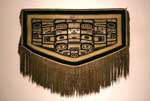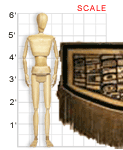VAM galleries including this work:
University of Kentucky Art Museum | Do You See a Pattern? | World of the Spirit || VAM Home
North American, Pacific Northwest, Tlingit, Chilkat
CEREMONIAL ROBE, c. 1900
Wool and cedar bark; 55" X 84"
Gift of Dr. Harvey Slatin, 79.22
University of Kentucky Art Museum
The Tlingit people, from near the Alaska-Canada border, adopted the art of blanket weaving from the neighboring Tsimshian people through trade and marriage, then went on to develop their own distinctive style. The weavings, called robes or blankets, were worn for ceremonial practices, used as valuable trade objects, and hung outside grave houses to express honor and respect. This particular robe, nearly symmetrical, is an excellent example of its type. The symbols and totem animals and forms would have been familiar to all tribe members. The patterns were highly stylized; animals were shown as if sliced down the center and laid out flat. The central motif in this robe has been interpreted as a diving whale, with its wide-spaced eyes at the lower corners, the body with flippers in the center, and the upturned tail at the top. Some scholars have interpreted the prominent face at the center of these diving whale images as the whale’s blowhole. The muted palette was derived from plant and animal dyes.
About the Artist
Typically, Tlingit blankets were expensive to make and took nearly a year to complete. They were created in a collaborative effort between men and women. Men were in charge of creating the design, providing the goat hides for wool, and preparing the pattern board and loom. Women saw to gathering cedar bark, preparing the yarn, and completing the actual weaving.
Classroom Ideas
Discussion: What geometric shapes do you see in this robe? What is repeated? Do you see a diving whale? What else might this figure suggest? What is symmetrical and what is not symmetrical about this weaving?
Activity: Use geometric shapes to draw an animal in a stylized, symmetrical way. Use your drawing as the basis for a miniature felt blanket, re-creating your pattern by cutting and gluing colored pieces of felt to a background piece of felt.
Links
See examples and read more about the process and significance of Chilkat weaving at the Sheldon Museum and Cultural Center.
[sheldonmuseum.org/chilkatblanket.htm]
Preserving the Tlingit ‘fringe about the body’, an article about a particularly successful and prolific Chilkat Tlingit weaver, is at Juneau Empire Online.
[juneauempire.com/stories/042104/nei_fringe.shtml]
Read more about the culture and heritage of the native Alaskan peoples at the Alaska Native Heritage Center.
[www.alaskanative.net/38.asp]

